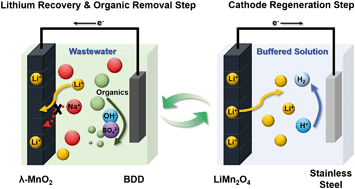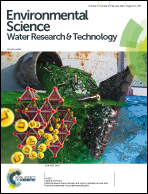Electrochemical lithium recovery and organic pollutant removal from industrial wastewater of a battery recycling plant†
Abstract
Lithium has become one of the most important elements due to the rapid development of mobile devices and electronics lately. There has been a steep increase in the global demand for lithium, and developing an economic supply of lithium is thereby important for battery industries. This study presents a new method for recovering lithium in wastewater from battery recycling plants, in which a considerable amount of lithium (∼1900 mg L−1) is discarded. There was a significant amount of organic pollutants present in the wastewater (∼300 mg L−1 of dissolved organic carbon), and so to resolve this, we proposed an electrochemical system containing a lithium-recovering electrode (lithium manganese oxide, LMO) and an oxidant-generating electrode (boron-doped diamond, BDD) to simultaneously recover lithium and decompose organic pollutants. Repeated operation of the electrochemical system demonstrated highly efficient and reliable lithium extraction and organic material removal from wastewater. After the lithium recovery system operation, a lithium-rich solution (98.6 mol% lithium among cations) was obtained, and the organic pollutants in the wastewater decreased by 65%. Furthermore, the electrochemical behavior of LMO and BDD was investigated under various operating conditions to provide useful insights into the industrial applications of our LMO/BDD system.



 Please wait while we load your content...
Please wait while we load your content...